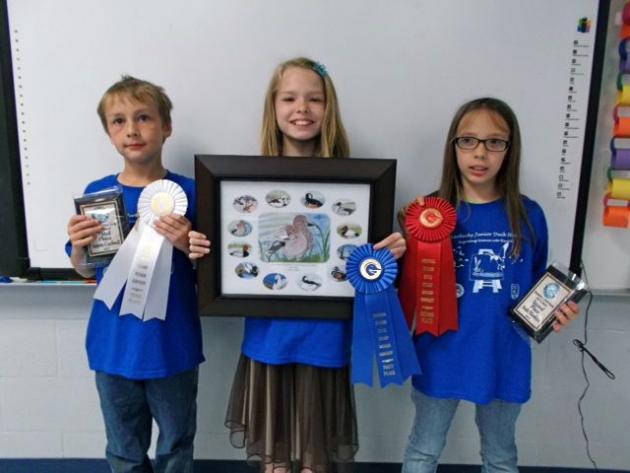NBE students receive awards from Junior Duck Stamp Program
This year North Butler Elementary participated in the Kentucky Junior Duck Stamp Program. The school had many students receive awards. In the state, over 1,500 students participated. 1st place received $100 check, a duck call, a copy of their artwork framed, a t-shirt, and a ribbon. Students with 2nd, 3rd place and honorable mention received a plaque, t-shirt, and a ribbon. Students receiving special award were given a ribbon and a rubber duck.

Below is a list of NBE award winners:
1st Place- Jaelyn Taylor
2nd Place- Andi Hawkins
3rd Place- Austin Cardwell
Honorable Mention
Kierra Flener
Tanner Merideth
Taylor Miller
Mattie Smith
Johnny Staples
Mary Tomes
Briley Webster
Skyler Whitehead
Lydia Smith (not in photo)

NBE also had 64 special awards.
"We're proud of our students and staff for their participation in the Kentucky Junior Duck Stamp Program," said NBE Principal Jeff Jennings. "They worked really hard on this project and represented our school well."
* * *
About the Junior Duck Stamp Program (below is an excerpt from its website (http://www.fws.gov/juniorduck/States/Kentucky.htm)
The Federal Junior Duck Stamp Conservation and Design Program (JDS) is a dynamic arts and science curriculum that teaches wetlands and waterfowl conservation to students in kindergarten through high school. The program incorporates scientific and wildlife management principles into a visual arts curriculum, with participants completing a JDS design as their visual “term papers."
The JDS has increased in popularity significantly since its inception in 1989 and even more since the implementation of a national art contest and stamp in 1993. The program was first recognized by Congress in 1994 when the Junior Duck Stamp Conservation and Design Program Act was enacted. In 2000, Congress reauthorized the program and expanded it from 17 states to include students in all 50 states, the District of Columbia and the U.S. territories.
More than 27,000 students enter state JDS art contests each year. While the program’s data collection methods do not account for students who participate in curriculum activities without submitting artwork, it is estimated that hundreds of thousands of students have been educated on the importance of waterfowl and wetlands conservation since the enactment of the 1994 legislation.
Revenue from the sales of the JDS goes to support awards and environmental education for students who participate in the program, as well as efforts to market the stamp.
Preparation for the Junior Duck Stamp contest and involvement in the program requires students to think about and understand at least the fundamental principles of anatomy and environmental science, and can be a valid barometer of a student’s grasp of these topics. The program also provides an opportunity for students to learn science and artistically express their knowledge of the beauty, diversity and interdependence of wildlife. Preparation for the program often includes a visit to a national wildlife refuge - a prime location not only for observing our nation’s wildlife, but also for having hands-on experiences in hundreds of visitor centers located within refuges.
The Junior Duck Stamp contest begins each spring when students submit their artwork to a state or territory contest. At the state level, students are judged in four groups according to grade level: Group I: K-3, Group II: 4-6, Group III: 7-9 and Group IV 10-12. Three first, second and third place entries are selected for each group. A “Best of Show” is selected by the judges from the 12 first-place winners regardless of their grade group. Each state or territory Best of Show is then entered into the national Junior Duck Stamp Contest. To further the interdisciplinary underpinnings of the program, students are encouraged, but not required, to include a conservation message on their entry form with their art design. The conservation message is judged in some states and at the national level for all Best of Show winners. The message explains something the student has learned about wetlands habitat, conservation or waterfowl. It may also be a statement used to encourage others to participate in conservation.
The winning design from the national contest is used to create the Junior Duck Stamp for the following year. Junior Duck Stamps are sold by the U.S. Postal Service and Amplex Corporation consignees for $5 per stamp. Proceeds from the sale of Junior Duck Stamp support conservation education, and provide awards and scholarships for the students, teachers and schools that participate in the program.
- Log in to post comments



























